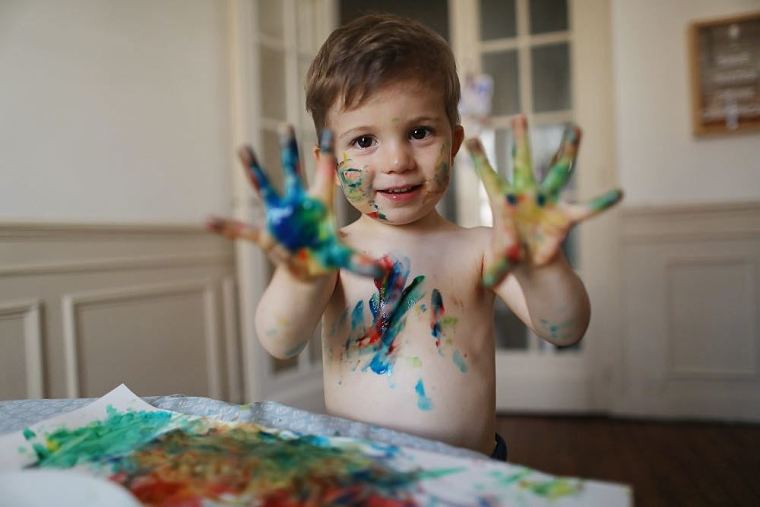Did you know that when children learn colors, they also work on a variety of skills? That’s right! By teaching them about colors, you will support their development.
When children learn colors they do much more than distinguish between one shade and another. During these moments, they also develop other skills that you may not even think about. It’s no wonder that babies are drawn to colorful objects.
They tend to stare, interact, and babble a lot when they’re in front of brightly colored objects. Thanks to that, they work on their motor coordination, language acquisition, and even their spatial notion. Observing colors has all these benefits and this interaction is very positive for their development.
Do you want to know why it is important that children learn colors? In this article, we will tell you everything you need to know about this subject. Let’s go!
Why is learning colors important for child development?
As we said, while children learn colors they develop other skills. Human beings depend to a great extent on the information we receive through sight. Visual recognition is so complex that it requires a series of cognitive processes to happen, such as attention, memory, language, and conceptual reasoning.
Once your child learns to differentiate between basic colors and different shapes, this will lay the foundation for a wide range of skills, such as memory, language, abstract thinking, integrating information, etc.
Healthy habits
Did you know that it is possible to use colors to develop good eating habits? That’s because the color of healthy foods ends up attracting children’s attention. Fruits, vegetables, and greens have a huge variety of shades that can be used in favor of a balanced diet.
We know that most parents find it difficult to get their children to eat well. That’s why relying on colors is a great idea. For example, if you teach your child that an apple is red, that could grab their attention and invite them to taste the fruit.
How to help your child learn the colors
As we said, it is natural for your child to pay attention to colorful objects. So, take advantage of this interest to teach them to distinguish different colors. An interesting idea is to organize a color-themed week.
During the week, you can feature a color. Try to make sure it appears on objects your child sees around them, on the clothes you both wear, on the foods you eat, etc. This way, they will focus on a specific color, learning about it. The following week, pick another color and so on.
Remember that toddlers learn quickly and that the skills they develop build the foundation for developing even more complex ones in the future. Often, the simplest games, such as learning colors, do the most for your baby’s development.
Learn colors with Kinedu activities
In the Kinedu app, in addition to offering you classes with experts, science-based articles, and progress reports, you will find activities that will help your child develop their skills. Now, check out our suggestions of activities to learn colors with your baby!
Colored doodles
This activity for children 14 months and older is ideal for promoting autonomy, motor coordination, and creativity. To do it, you will need some crayons, a rubber band, and sheets of paper. Tie three or four crayons with the rubber band and give the paper to your child to scribble.
To make it even more fun and stimulating, you can accompany the activity with music. Afterward, save the “artwork” as a reminder of this beautiful stage in your little one’s life.
Salty colors
This activity for children 23 months and older will help your little one explore their creativity, in addition to stimulating their fine motor skills and, of course, learning about colors. You will need paper, glue, salt, and paint.
Ask your little one to help you cover a drawing with glue and then salt. Then let the drawing dry to start the game. Tell your child to trace the figure again, but this time using their finger and paint.
At this point, you can help your child by showing them how to make the strokes and by teaching them the names of the colors. Use their creativity by mixing colors to paint the figure. When they finish painting, take a closer look at the paint-covered grains of salt. Keep playing until your little one gets tired.
Colored crayons
This activity is very simple, but also very stimulating for creativity and fine motor skills. The materials you will need are sheets of paper and colored crayons. On a comfortable table, place several crayons and let your child scribble freely on the sheets.
You can also help them draw lines, shapes, and figures while saying the name of each color. Let your little one explore the materials and their creativity for as long as they want.
Primary colors
Your child can learn the primary colors with this activity. Give them red, blue, and yellow cards and paints, white paper, and paintbrushes. Start by showing them the cards by saying the color of each one and ask them to identify them. Praise them whenever they give you the right answer!
Then, ask them to paint the paper with a brush or their finger using specific colors. Combine two colors and name the new one that has just been made. For example, the combination of blue and yellow results in green. In addition to teaching colors, this game helps your child develop their language and fine motor skills.
As your little one learns about colors, you can ask them to identify them in the clothes they are wearing, in what they eat, or in the books you read together.
As you have seen, when children learn colors they develop several important skills for their daily life. To access more daily activities that promote this experience, use Kinedu! Download the app for FREE.








